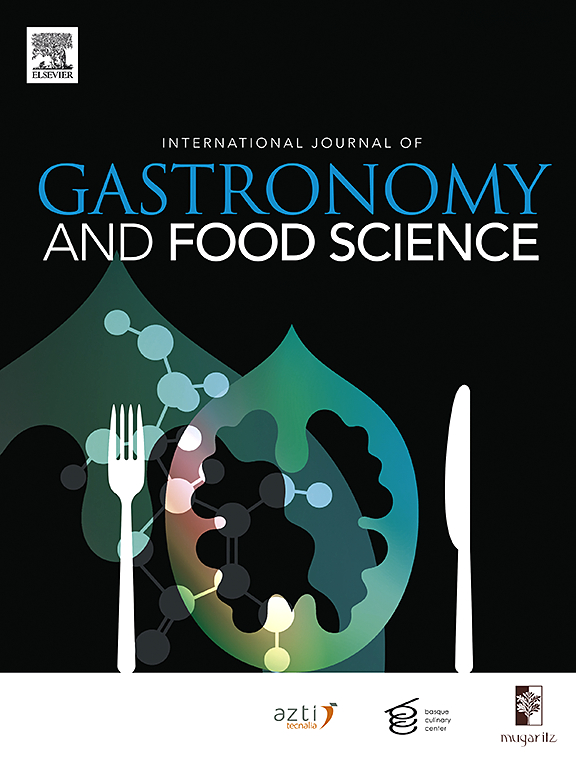Dried shrimp in Bahian food culture: An ancestral ingredient and a culinary identity
IF 3.2
2区 农林科学
Q2 FOOD SCIENCE & TECHNOLOGY
International Journal of Gastronomy and Food Science
Pub Date : 2024-11-15
DOI:10.1016/j.ijgfs.2024.101064
引用次数: 0
Abstract
The cuisine of Bahia, a state in Brazil, originates from African, indigenous, and European cultures, and its recipes are widespread in books and popular knowledge. Among the characteristic ingredients is the dried shrimp, which is used as a seasoning or as the main ingredient. This study sought to investigate the first uses of dried shrimp and its roles in Bahian cuisine. A review was carried out, based on classic books on Brazilian and Bahian dishes and a survey of recipes using dried shrimp, identifying the names of the dishes, ingredients, and preparation methods. Fourteen books were found that dealt with the uses of dried shrimp, and fifty dishes were recorded. Based on the books, the origin of the use of dried shrimp is linked to the practices of African origin, although it was not possible to precisely explain its introduction into Bahian food. Among the dishes were sauces and braised foods, which mainly use vegetables such as yams, corn, and beans, or include animal-derived ingredients, such as poultry and offal. Popular dishes such as acarajé, caruru, and vatapá stood out, as did some votive dishes such as amalá and ipetê, and others that are no longer used, such as badofe. Among the authors, differences in the ingredients and ways of making some dishes were perceived, which expresses culinary dynamics over time and in the multiple territorial configurations where they are made. The study highlights the secular and traditional use of dried shrimp in Afro-Bahian food culture, associating an active and changing process in preparation and consumption practices. Given the difficulty in identifying in detail the origin of the use of dried shrimp in dishes, future studies based on historical research are reaffirmed.
巴伊亚饮食文化中的虾干:一种祖传食材和一种烹饪特征
巴西巴伊亚州的美食源于非洲、土著和欧洲文化,其食谱在书籍和大众知识中广为流传。虾干是其特色配料之一,可用作调料或主料。本研究试图调查虾干的最初用途及其在巴伊亚美食中的作用。根据有关巴西和巴伊亚菜肴的经典书籍和使用虾干的食谱调查,确定了菜肴名称、配料和制作方法,并进行了回顾。结果发现有 14 本书介绍了虾干的用途,并记录了 50 道菜。根据这些书籍,使用虾干的起源与源自非洲的习俗有关,尽管无法准确解释其引入巴伊亚饮食的原因。这些菜肴包括酱汁和烩菜,主要使用山药、玉米和豆类等蔬菜,或使用家禽和内脏等动物性食材。acarajé、caruru 和 vatapá 等受欢迎的菜肴,以及 amalá 和 ipetê 等一些祭祀菜肴,还有一些已经不再使用的菜肴,如 badofe,都非常突出。作者们发现,一些菜肴的配料和制作方法存在差异,这反映了烹饪随着时间的推移和菜肴制作地的多重地域配置而发生的变化。这项研究强调了干虾在非洲-巴希亚饮食文化中的世俗和传统用途,将制作和消费习俗中一个积极和不断变化的过程联系起来。鉴于难以详细确定在菜肴中使用虾干的起源,今后基于历史研究的研究再次得到肯定。
本文章由计算机程序翻译,如有差异,请以英文原文为准。
求助全文
约1分钟内获得全文
求助全文
来源期刊

International Journal of Gastronomy and Food Science
Social Sciences-Cultural Studies
CiteScore
5.30
自引率
10.50%
发文量
170
审稿时长
45 days
期刊介绍:
International Journal of Gastronomy and Food Science is a peer-reviewed journal that explicitly focuses on the interface of food science and gastronomy. Articles focusing only on food science will not be considered. This journal equally encourages both scientists and chefs to publish original scientific papers, review articles and original culinary works. We seek articles with clear evidence of this interaction. From a scientific perspective, this publication aims to become the home for research from the whole community of food science and gastronomy.
IJGFS explores all aspects related to the growing field of the interaction of gastronomy and food science, in areas such as food chemistry, food technology and culinary techniques, food microbiology, genetics, sensory science, neuroscience, psychology, culinary concepts, culinary trends, and gastronomic experience (all the elements that contribute to the appreciation and enjoyment of the meal. Also relevant is research on science-based educational programs in gastronomy, anthropology, gastronomic history and food sociology. All these areas of knowledge are crucial to gastronomy, as they contribute to a better understanding of this broad term and its practical implications for science and society.
 求助内容:
求助内容: 应助结果提醒方式:
应助结果提醒方式:


